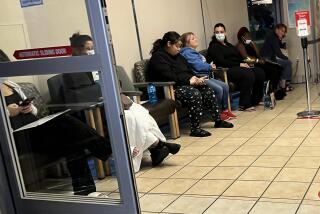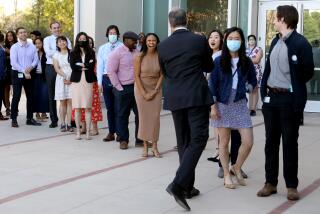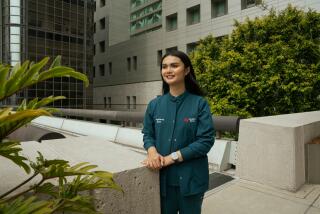A Huge Dose of Change
One measure of how times have changed, Dr. Florence Haseltine says wryly, is that she hasn’t had to hit a man in years.
During her medical training a generation ago, Haseltine out-toughed the tough guys. When colleagues taunted or slighted her, she sliced them with her wit. An especially cheeky comment was answered with a punch or shove.
“I picked up [one male instructor] and threw him on the ground,” said Haseltine, one of seven in her medical school class 30 years ago. “You can do anything when you take somebody by surprise. He was little anyway.”
Haseltine, 57, now editor of the Journal of Women’s Health, belonged to a generation of female physicians who did best if they downplayed being female. Back then, “you’d better think like a man,” she said. “My patients used to say, ‘You’re no lady.’ ”
She is hopeful that her daughter, a premedical student, will inhabit a very different, far more humane, medical world.
Just in the space of Haseltine’s career, the increasing influx of women into medicine has transformed medical education, practice and research. It has expanded the very definition of what “health” means.
The statistical gains are striking. Although three-quarters of practicing physicians are males, about 43% of incoming medical students are female, compared with 9% in 1970. At several prestigious medical schools such as Stanford, UC San Francisco and UCLA, women currently make up more than half the first-year class.
Female doctors and medical scholars have thrown their weight behind the health care consumer movement, pushing for more dollars devoted to breast cancer and other diseases common among women. They have successfully lobbied to have women patients included in more clinical trials.
“We are modifying explanations of what the norms in medicine should be, because they were developed by men, for and about men,” said Vivian Pinn, director of the decade-old federal Office of Research on Women’s Health.
Tapping their experience as women, female physicians have helped to widen the boundaries of medicine, ushering in consideration of violence, poverty and other social conditions as health issues.
“The fact that women are now asked [by their doctors], ‘Have you been in a violent relationship, and do you feel safe?’; the fact that it is now a standard of care . . . is a clear example of how women have influenced priorities in public health,” said Dr. Carolina Reyes, a perinatologist at Cedars-Sinai Medical Center in Los Angeles and a senior scholar for the federal Agency for Health Care Quality and Research.
And yet, many female doctors and their advocates see this transformation of medicine as incomplete, even stalled.
A century and a half after the first woman graduated from an American medical school, women remain vastly underrepresented in medicine’s leadership ranks--in academia, medical societies and research posts. They often earn less money than men, even in comparable jobs.
A recent study in the New England Journal of Medicine underscored the problem, showing that although more women than men enter academic medicine, far fewer advance to senior positions.
About 60% of women enter what might be considered medicine’s more nurturing fields--family practice, internal medicine, pediatrics, psychiatry, and obstetrics and gynecology. Women are far scarcer in the more lucrative, high-tech enclaves of medicine, such as surgery, where training is often grueling and stamina prized.
This is not so much a matter of overt sexism or discrimination, experts say. It seldom involves the sort of offenses that Haseltine would have punished with a wallop.
The explanation is more subtle and complex--a function of doctor and patient preferences, the dearth of female role models in certain specialties and, perhaps most importantly, medicine’s unwritten rules. Traditionally, long hours and late nights have been the measure of a doctor’s dedication; the wife, of course, handled the home front.
Female physicians often are wives and mothers too. They still bear the bulk of family responsibilities, leaving them less leeway to climb the career ladder. Many see their toughest battle as making medicine more flexible, so that a strong family role is not treated as a professional liability.
“It’s still OK for men to close the door and say, ‘I’m spending the next 10 hours [working]--don’t bug me,’ ” said Janet Bickel of the Assn. of American Medical Colleges. “But it’s not OK for women to put their careers first.”
Differences in Approach
Does it really make a difference whether a physician is a man or a woman?
A series of studies suggests that women doctors tend to spend more time with patients, converse more and listen more. They are more inclined to inquire about patients’ lives, about their stresses and emotions. They encourage more participation from patients in their own health care and are more apt to push prevention.
Many of these gender differences are small, and exceptions are legion.
“I’m not a particularly charming person,” Haseltine quipped. “I think people could get just as irritated with me as any man.”
Researchers in no way conclude that women doctors are better or worse--only that their increased presence, on balance, changes the dynamics between doctor and patient.
Patients, particularly women, perceive a difference too, research has shown. Nearly 90% of female patients--compared with 25% of male patients--believe that women doctors’ style of practice improves patient care, according to one survey. And women’s opinions count more; studies have shown that they make the bulk of family health care decisions.
Almost nowhere are their preferences more pronounced than in obstetrics and gynecology. Women now claim two-thirds of the slots in ob-gyn residency programs. Their male counterparts report increasing trouble landing job interviews.
“Sometimes I get disappointed and a little hurt that [a patient] feels that I won’t listen to them or I won’t understand that they hate pelvic exams,” said Dr. Michael Manuel, an ob-gyn resident at Cedars-Sinai. But he also sees the situation as “a little bit of justice” for female patients, long deprived of choice.
Once taught to minimize their differences with men, many women physicians now say they have come to see their gender and feminine experiences as assets.
“Having been pregnant myself, I bring--without question--some empathy to the situation,” said perinatologist Reyes, the mother of three girls.
Many female physicians who came of age during the early years of the women’s movement read the take-charge consumer manual “Our Bodies, Ourselves” before they cracked open any medical texts. They are inclined to question the status quo.
They also tend to take a broad view of health care--to frame violence, poverty, stress and even educational attainment as medical concerns.
“You can’t take care of a disease and pretend it doesn’t have a social context,” said Dr. Laura Esserman, a UC San Francisco breast cancer surgeon, who is planning a day-care center for harried patients.
Perhaps nowhere has the influence of female doctors and scientists been more pronounced than in women’s health research, which saw unprecedented advances in the 1990s. Among them: creation of the Office of Research on Women’s Health, launch of a national initiative to study 150,000 post-menopausal women and abandonment of a long-standing government policy to exclude fertile women from clinical trials.
One result has been increased resources and attention to such issues as breast cancer and hormone replacement therapy. But researchers also have hit on the fact that women and men can have different reactions to the same diseases and drugs.
Consider the nation’s No. 1 killer, cardiovascular disease. It turns out that women, on average, get it 10 years later, have more elusive symptoms, more often go on to have more heart attacks or strokes and are more likely to die than men, research shows.
“We’ve been training generations of physicians not to think about gender differences,” said Assistant U.S. Surgeon General Dr. Susan Blumenthal, who was the nation’s first deputy assistant secretary for women’s health. “Women are saying now, ‘There are differences, [and] we need to look at them.’ ”
Like many female physicians of her generation, Blumenthal acknowledges that her personal experience as a woman is inseparable from her research interests. She views medicine not just as a doctor, but as a daughter. She helplessly watched her own mother fight two painful battles with cancer, a disease that ultimately killed her.
She still recalls the skull and crossbones on her mother’s hospital door, the radiation warning that terrified her as a 10-year-old. She remembers the hush-hush atmosphere surrounding her mother’s later bout with breast cancer. Doctors didn’t seem to have many answers, and they sure didn’t welcome questions.
“I realized how . . . little information there was and how much needed to be done. Watching her be devastated by that, I vowed that no one woman should have to suffer the way she did. I wanted to work in women’s health.”
Women Were Like Uninvited Guests
With the surge of women in medicine, it is easy to forget that the profession was once a boys’ club, with women often treated as uninvited guests. The digs used to be blatant, the discrimination crude.
Pinn was once told by a fellow male medical student that women’s brains were smaller than men’s, so why was she taking a man’s slot in school? Others recall the cartoons of nude women slipped in to spice up the anatomy lectures, the passes and wandering hands of male peers and instructors.
Sexual harassment still exists, women doctors say, but it’s not so apt to be winked at anymore. Discrimination, when it occurs, is more subtle. What’s left, critics say, are the more insidious obstacles to women’s career advancement.
Despite some significant breakthroughs in the past decade--appointment of Dr. Bernadine Healy as director of the National Institutes of Health and election of Dr. Nancy Dickey as president of the American Medical Assn.--women remain relatively scarce in the ranks of medical leadership.
On medical school staffs, just 11% of women are full professors, compared with 31% of men. A 1998 survey showed that 17% of women on medical school faculties were tenured compared with 33% of men. A handful of medical deans were female, as were only 6% of department chairmen.
Women physicians also make substantially less money, an average of $120,000 in 1997 compared with $175,000 among men. They are far less inclined to enter the more time-guzzling, well-compensated areas: general surgery and subspecialties including neurosurgery, orthopedic surgery and cardiothoracic surgery.
Some of this may be by choice. More women than men may prefer pediatrics to brain surgery. They may decide to work fewer hours and see fewer patients, and thus make less money. They may want to limit their time in the lab or office--maybe take a staff job with regular hours--so they can attend their children’s soccer games.
But many women physicians point to other factors. Frances K. Conley, a Stanford neurosurgeon whose story of sexism in academic medicine was chronicled in a 1998 book, “Walking Out on the Boys,” senses basic economic discrimination. In her view, women are being funneled into less prestigious branches of medicine, which are becoming even more devalued.
“There’s nothing wrong with primary care,” she said, “but because it’s [taking in more] women and they don’t have the clout to run the medical world, they are going to take a position of less prestige and pay.”
Other women say their progress is hindered by a lack of role models and mentors. “We need to see other women doing what we dream of doing,” said Dr. Valerie K. Ulstad, a Minnesota internist.
Perhaps most important, many women contend that medicine’s hard-driving culture sets up impossible conflicts between career and family.
The notions of part-time work and job-sharing in medicine are not unheard of, but they aren’t widely embraced either. As for medical training, which often coincides with women’s most fertile years, residents say it’s still a lot like the Army. Women contemplating pregnancy no longer have to ask permission or seek forgiveness--they are entitled to family leave--but once the baby is born, working every third night at the hospital is a strain.
Critics argue that both male and female physicians would benefit from more flexibility in their professional lives.
“Medicine in general is a macho field . . . for women . . . [and] men,” said Dr. Denise K.C. Sur, director of the family practice residency at Santa Monica UCLA Medical Center.
Esserman, speaking into the phone as her son Max toddled around her office, agreed. “As long as women say, ‘It’s our problem,’ it’s not going to change. . . . Men should want to be part of their families too.”
In fact, some male medical students and residents say women’s presence has changed the culture of medicine enough to give men new options as well. Not many men in past generations would reject a surgical residency in radiology for “family reasons.” But that’s exactly what 27-year-od UCLA medical student Tyler Crawford did.
“Surgery is one of the hardest [residencies],” said Crawford, 27, a new father who is married to a fellow medical student. “ I just didn’t feel good about putting that much time in and leaving the raising of our daughter to my wife and other family members.”
At the same time, there are women who want nothing more than to be premier, super-specialized surgeons. “If you want to take it on, you have to devote your whole life to it,” said Dr. Kathy E. Magliato, a cardiothoracic surgeon often mistaken by patients for a nurse.
Magliato, the daughter of apple farmers, decided on her career path early in her medical training, the very first time she took a temporarily stilled human heart into her hands. It seemed a miracle to her, to be able to stop and start a heart, to be entrusted with what many see as the seat of the soul.
“Wow,” she thought, “I can do this every day.”
With no female role models--but help from male mentors--she survived 15 years of post-college training. She just landed her first independent job last year at age 36, as Cedars-Sinai’s first female heart surgeon.
She put her life on hold, put her job ahead of everything else. She just recently got engaged--to a liver surgeon--and hasn’t had much chance to think about having children. She confesses that she doesn’t have enough time during the day to go to the dry cleaners.
She loves her job. She’d like nothing more than to pave the way for other women surgeons, but she cautions, “You have to be tough--very, very tough. It’s grueling, physically and mentally. . . .”
Unless the rules change, that’s not a path likely to attract young, family-oriented physicians in droves.
“It comes down to what kind of life you want,” said Tracy Kritz, a 31-year-old UCLA family practice resident who decided against becoming a surgeon.
She wants a medical career and, pretty soon, a family. She respects the “superwomen” who pursue both dreams without scaling back either one, but “for myself,” she said, “I have no need to be a pioneer.”
(BEGIN TEXT OF INFOBOX / INFOGRAPHIC)
Women in Medicine
Women’s presence in the medical profession has grown substantially since the 1970s. At some major medical schools in California and elsewhere, they currently account for more than half the first-year class. Yet female physicians are less likely than men to reach top academic ranks and, in practice, are vastly underrepresented in certain lucrative specialties. *
*
Sources: Assn. of American Medical Colleges, American Medical Women’s Assn.,
American Medical Assn.
*






